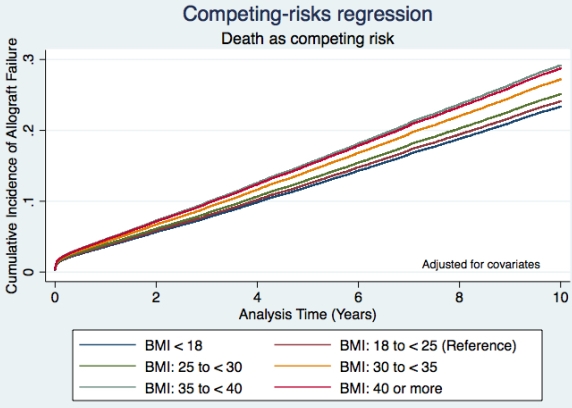Impact of Elevated BMI on Allograft Outcomes: A Competing Risks Regression Analysis
A. Naik, A. Sakhuja, M. Samaniego, P. Shrivastava, D. Cibrik.
Section of Nephrology, University of Michigan, Ann Arbor, MI.
Meeting: 2015 American Transplant Congress
Abstract number: 377
Session Information
Session Name: Concurrent Session: Kidney: Cardiovascular and Metabolic
Session Type: Concurrent Session
Date: Tuesday, May 5, 2015
Session Time: 2:15pm-3:45pm
 Presentation Time: 2:15pm-2:27pm
Presentation Time: 2:15pm-2:27pm
Location: Terrace I-III
INTRODUCTION: Extremes of BMI has been associated with an increased risk of death censored allograft failure. Traditionally the KM product limit estimate has been used to calculate the cumulative all cause death censored allograft failure. However such an analysis may overestimate the risk of failure since subjects that experience a censoring event (death, lost to follow up or with functioning graft at last follow up) are treated as if they could later experience the event of interest, however in the case of death this is not possible.
METHODS: We used OPTN/UNOS database from 2001- 2010 and included first transplants aged 18-70 in our analysis. Multi-organ transplants, SPK, PAK and patients that underwent re-transplantation were excluded from the analysis. A competing risk regression model was used to assess allograft failure (due to failure, death, last follow up) with death as a competing event. BMI was stratified into 6 different strata (< 18, 18 to <25, 25 to < 30,30 to < 35, 35 to <40 and >40) and adjusted for age, gender, race, diabetic status, HLA mismatch level, cold ischemia times, type of kidney received (Living, SCD, ECD) PRA at the time of transplant and donor age. No imputations were done for missing data. Proportional sub-hazard assumptions were tested using interaction of all covariates with time. All data was analyzed by STATA 13.0 (College Station, TX)

RESULTS: After applying inclusion and exclusion criteria a total of 125,189 patients were available for analysis. In our competing risk regression analysis using death as a competing model using normal BMI (18 to <25) as reference the SHR (sub hazards) for BMI less than 18 was 0.96 , P=0.60, BMI 25 to < 30 (SHR=1.04, P=0.02), BMI 30 to < 35 (SHR=1.15, P=<0.001), BMI 35 to <40 (SHR=1.25, P= <0.001) and >40 (SHR=1.23, P=<0.001) after adjusting for co-variates.
CONCLUSION: Using a competing risk regression we were able to demonstrate a detrimental impact of increasing levels of BMI on graft survival. Unlike previous studies we did not identify low levels of BMI to have any impact on graft survival.
To cite this abstract in AMA style:
Naik A, Sakhuja A, Samaniego M, Shrivastava P, Cibrik D. Impact of Elevated BMI on Allograft Outcomes: A Competing Risks Regression Analysis [abstract]. Am J Transplant. 2015; 15 (suppl 3). https://atcmeetingabstracts.com/abstract/impact-of-elevated-bmi-on-allograft-outcomes-a-competing-risks-regression-analysis/. Accessed December 13, 2025.« Back to 2015 American Transplant Congress
